Our Life in West Kowloon --- Society for Community Organization
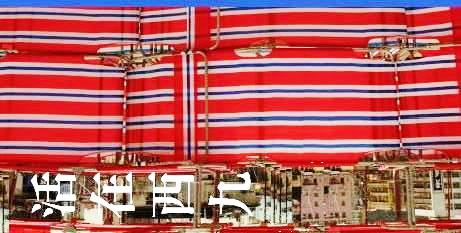      |
|||||||||||||
|
Our Life in West Kowloon --- Society for Community Organization
Contact Us Order form
|
|
|
|
|
|
|
|
|
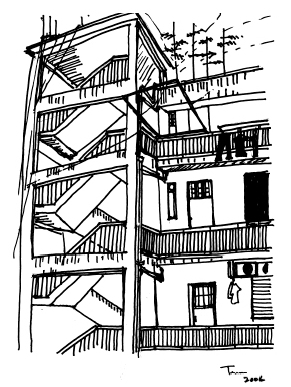 |
|
|
|
|
|
|
|
|
|
Involvement
of the Residents It has been really satisfying and interesting installing the
fold-up beds with so many local residents. I never imagined that they
would be so excited and devoted to the exhibition, and both their sense
of beauty and concern for safety have also surprised me. Praise and
appreciation light up their days. Art is no longer a distant and abstract
concept, if it takes on a deeper and fuller meaning by becoming part
of life and involving the entire community. Extending
the Spirit of the Exhibition Although the exhibition will only run for one month, its spirit shall live on. We urge people to donate nylon fold-up beds to those in need, especially poor families and the homeless. Let the exhibition continue in another form, with a sense of care and love for others. Standing on a rooftop on Kweilin Street, you can see Cheung Sha
Wan just around the corner, and Wan Chai and Central in the distance.
Everywhere seems so near, and yet so far. However, as we look up to
the sky, we can all find a place of our own. |
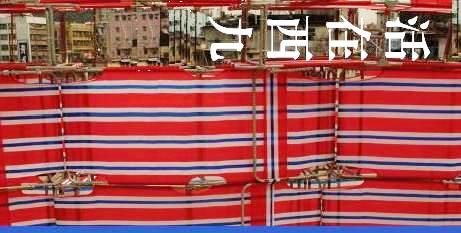       |
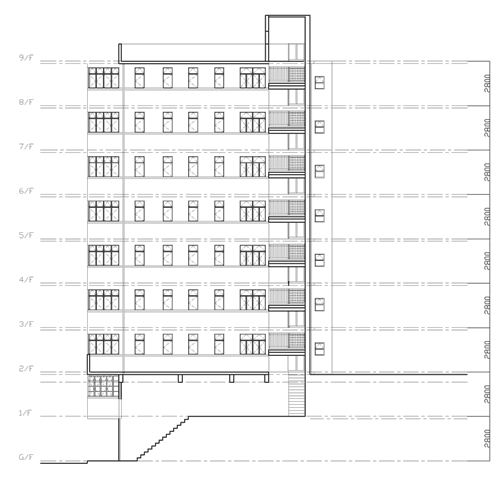 |
Building structure of 115 to 119 Kweilin Street by C.C. LEE (1959) |
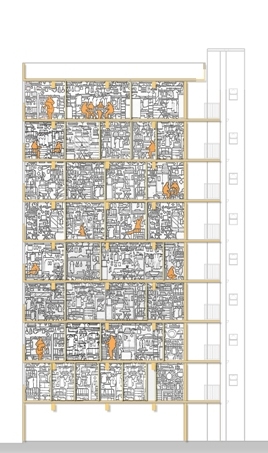 |
|
|
Surrealistic Fold-up Bed Installation in the 'Sky
Garden' |
 |
|
|
|
|
|
       |
|
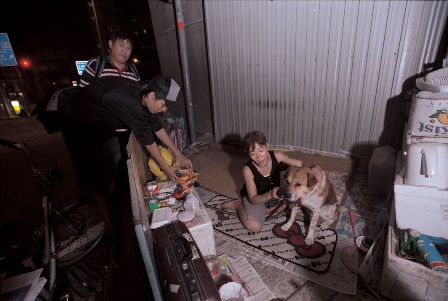 |
|
|
Realities of Life in a Partitioned Room
In four partitioned rooms in an old Chinese tenement on Kweilin Street, we present the stories of the underprivileged: a poor, elderly couple; children living in partitioned rooms; a new immigrant, victimized by discrimination; a mentally-ill old man; and a single lady suffering from depression.
Five Senses
1. Touch - Kam Ho and Her Little Dog
Kam Ho, a 33-year-old single lady who has been suffering from depression for two years, lives alone in a small rented room in Sham Shui Po. The walls of her room are totally covered in old, faded Hello Kitty stickers. Yet, Kam Ho is not alone; she has her beloved companion, a little dog (a Pekinese). She first came across the dog a year ago, and it was only then that her depression stabilized. After weeks of struggle, she decided to keep the Pekinese, and the two have been inseparable ever since.
Kam Ho's 'home' is tiny, with mostly sex wokers and secondhand goods traders living next door. Her room is messy - the ashtray in front of her Kwun Yum (Goddess of Mercy) portrait is full of cigarette butts. The room has no window and the air-conditioner is very old and noisy. Kam Ho's little dog likes jumping up and down and when tired, it lies on Kam Ho's slim thighs. While Kam Ho tries hard to appear relaxed, her wrinkled face and grey hair betray her.
Kam Ho and her first husband were drug addicts, and the two of them almost lost everything. When they separated, her ex-husband took custody of their two children, and since then, Kam Ho has not been allowed any contact with them. The children have now grown up and lead independent lives. Even though Kam Ho misses them a great deal, she hasn't dared to contact them for fear of interfering in their lives.
After another failed marriage, Kam Ho became pregnant with another man's child. Unfortunately, she lost the baby late in the pregnancy. The loss of her baby girl has haunted Kam Ho ever since, "I always feel that she is by my side, as if there's one more person in the room..." Kam Ho believes that this caused her mental illness.
She feels safe whenever she has her dog in her arms. Every time we visit Kam Ho, she is hugging the dog. Wherever she goes, the dog is with her. Whenever she feels down, her doggy is by her side. Kam Ho does not have many friends: she only knows a fellow depressive. However, when she walks her dog, she now has a chance of making new friends with fellow dog-lovers. It seems that the little dog is not only Kam Ho's best friend, but maybe also a 'doctor' that can heal her soul.
Hug - an intimate touch which shows someone just how much you care. Do you remember that feeling?
Here, the exhibition organizers encourage visitors to re-live their own childhood memories, by touching the exhibits of ordinary items which were common in years gone by, such as a bamboo mat, a striped nylon fold-up bed, and an old-style room divider with a glass window at the top.
|
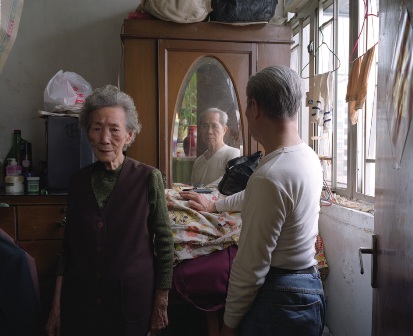
|
|
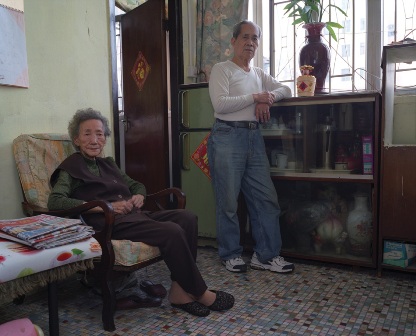 |
|
|
|
||
|
After completing her junior secondary education in China, Jin worked as a baker. When she came to Hong Kong, she couldn't find work as a baker, so she took a job at a local cafe. She worked very hard there and was popular with her fellow colleagues and customers, trying her very best to adapt to the culture here. Despite this, Jin's dark and athletic appearance makes it easy to identify her as an immigrant, so she often suffers discrimination when looking for work or going shopping. Jin hasn't taken this to heart. After all, she's done nothing wrong.
Two years later, Jin became pregnant, and after a great deal of thought, she decided to have the baby. With the birth of her baby daughter, Ka Yee, life became very difficult: she had to leave her job to take care of the baby, all of her savings had gone, and her husband's immigration application was still pending. Jin had no choice but to apply for CSSA. She and her baby girl lived in a 40 sq.ft. partitioned room amongst the rats and cockroaches. Since their room was next to a kitchen with LPG containers, she often worried about their safety. Life was really tough for Jin, but she was confident of her future: once little Ka Yee attended kindergarten and her husband was allowed to come to Hong Kong, she would be able to stand on her own feet again. Jin also hoped that the restrictions regarding immigrants' applications for public housing units would be lifted in the hope that one day, she might be offered one.
"I'll accept any offer no matter how old the unit is, so long as the rent is cheap. We just need a place to live. The most important thing is that the whole family can be together."
Jin's wishes all came true by the end of 2005. The government relaxed the restrictions, and after five long years, Jin was granted a public housing unit. Approval for her husband and son to join her here was also subsequently granted. Her family of four squeezed into a small unit for two, and yet they were all very happy. Both Jin's husband and son work at construction sites as casual workers. Although their income is still rather unstable, Jin lost no time in terminating her CSSA benefit.
Since child-care is so expensive, Jin has to take care of Ka Yee herself and is therefore unable to find a job. To make her way, Jin collects paper cartons, soft-drink cans and metal scraps in the industrial districts early every morning and sells them for tens of dollars each day. Though life is tough, she lives it with great enthusiasm. After school, Ka Yee helps her mother by pushing the garbage cart, collecting paper cartons and soft-drink cans, and selling them. Amidst the adversity, perhaps their laughter tells you how 'new immigrants take on life's highs and lows.'
|
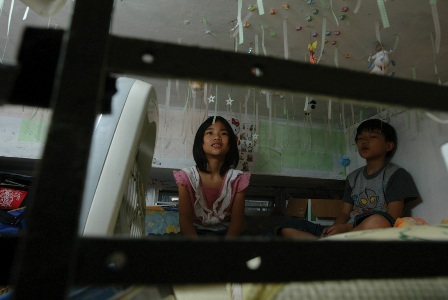 |
|
|
|
|
|
|
|
|
|
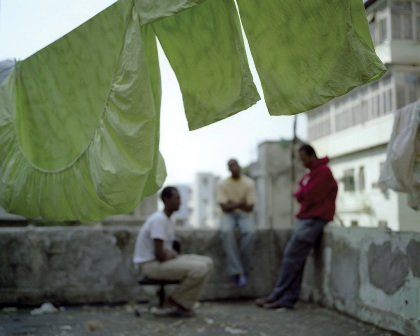 |
|
|
|
4. Sight - Yau Mung Ching's World of Books
'An empty dream at midnight faints; Joy and laughter are in vain.'
These verses were written by Yau Mung Ching, a 73-year-old man as a reflection of his life. He lives on CSSA in a partitioned room less than 60 sq. ft. Yau has a collection of 2,000 plus Chinese poetry, literature and history books, many of which are very valuable, out-of-print, string-bound books. In spite of the huge number, they are all categorized and well-organized in various plastic bags. "I've just spent $400 on a hardback set of 'Comprehensive Mirror for Aid in Government'. I know I don't have enough space for it…but it's so valuable that I just had to have it" he said, pointing to his new acquisition, whilst taking plain congee and vegetables for supper. Over the past thirty years, Yau has been suffering from mental illness due to an obsession with books when he was much younger. He used to spend all his time, days and nights, reading Chinese poetry and literature, and eventually this obsession led to his mental exhaustion.
"I treasure the 76-volume 'Complete Prose Literature of the Tang Dynasty' the most. Only the Palace Museum in Beijing has the same collection. This old-style, string-bound edition is out of stock now" he added. "I keep them all on the bookshelf above my bed and read them once in a while to revisit the treasure of literature." The most expensive set of string-bound books owned by Yau cost him $1,000. According to him, their value has appreciated over the years. Yet, price is not meaningful to him, possession is far more important. Books are his only friends; he has spent most of his life surrounded by old books.
Yau has suffered from panic disorders for over forty years, and he's always been poor. He was orphaned at fourteen when his parents starved to death during the war. He then came to Hong Kong from Chiuchow and worked in a rice store, a textile factory and a book shop. He has always loved reading books. Since he was sixteen, he'd always worked during the day and then read books, practiced Chinese calligraphy and recited poems until one or two at night. However at thirty-two, he started to develop mental problems, becoming very anxious and not being able to sleep for five consecutive nights. He couldn't concentrate on his work and lost his appetite. Since then, he has had to rely on medicine and has been in and out of hospital regularly. Despite all of this, he still continued to work hard and only retired at fifty-seven when his health started to fail. I have known Yau for about eight years, and I've always felt that he didn't belong to this materialistic world. For him, life is just about reading and buying books. He's totally isolated from the outside world and doesn't even have a single relative or friend. Whenever his mental state bothers him, he only has social workers to take him to the hospital and accompany him to follow-up consultations. "Although I don't have any friends, I'm not lonely" he said. "Books are my best friends. Reading books is just like talking with great writers and poets, it lights up my life." Unfortunately, Yau has had a cataract since last year and he is now very depressed, "I can't read anymore. My best friend has left me, I'm so lonely!" I once witnessed the effects of Yau's mental illness and realized how incapacitating it could really be. Around August last year, I and some fellow social workers visited Yau's tiny room, which was boiling (maybe 35°C or 36°C), and found him motionless, blankly staring straight ahead. He'd been sitting on his wooden bed for days, without eating, resting or speaking. We couldn't get him to respond, and eventually, the situation was so bad that we decided to take him to hospital. Several ambulance men struggled to carry him down to the ambulance. His body was still stiff and cold as he lay in the hospital bed; perhaps reflecting his lonely and desolate state of mind. Yet the Yau I see today fears neither severe winter nor loneliness. He faces the challenges and difficulties of life, alone. All these years, he's never given up chasing his paradise within the confines of his tiny partitioned room.
A poem by Tang poet Liu Zongyuan surfaces:
Boundless mountains no birds in flight;
Endless footpaths no men in sight.
Lonely fisherman afloat;
Fishing in cold river snow.Since the partitioned room in the display is very dark, we have projected our interview with Yau onto a wooden board. We have also used over 100 books to build several pillars so that visitors have a real sense of being immersed in Yau's world of books.
|
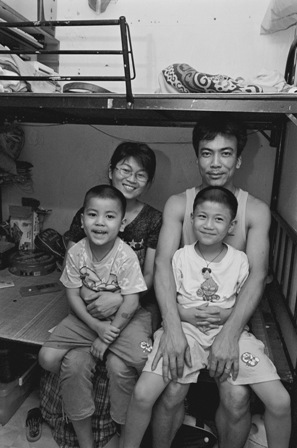
Despite being an experienced electrician, Fung did not have any recognized qualifications, which put him at a huge disadvantage when looking for work. Moreover, an electrician's license would cost thousands of dollars which was beyond his means. We got to know the Fungs during one of SoCO's family visits in 2004. With our help, Fung applied for a loan from our Employment Fund to pay for the licensing examination fee and succeeded in obtaining a formal qualification. Fung was appointed as the leader of the Repair and Maintenance Team as a result of his experience and dedicated attitude to work. He now leads a team of half a dozen unemployed skilled workers, who provide repair and maintenance services to the poor, elderly and single-parent families under our Maintenance Fund. In less than 18 months, the team has helped more than 150 families. The team's members have not only received warm praise for their work, but now also enjoy a stable income and can support their families. In mid-2006, the Fung family moved into a public housing estate. Their dream of having a home and a meal together finally came true. |
 |

1.1 Exhibition area
1.2 Special Event and Seminar
Books Order Form (Download order form)
Booking and enquiry: Ms.Ng/Tsang/Iman Fok
Tel.: 2713 9165 (Mon to Fri) / 2307 8165 (Sat to Sun)
Address: 1/F, 115 - 117 Kweilin Street, Sham Shui Po, Kowloon.
(opposite to the Exit C2 of Sham Shui Po MTR station)
Website: www.soco.org.hk E-mail:soco@pacific.net.hk
1.3 Photo exhibitions of the Disadvantaged groups
(April 21 to 26, 2007) Hong Kong Cultural Centre (Photo exhibition of People with Mental Illness)
(June 6 to 21, 2007) Hong Kong Cultural Centre(Streetsleepers)
Shopping Mall: (to be confirmed)
       |
Promotional Video and TV Programme
ATV 時事追擊 "民間博物館"
http://app.hkatv.com/webtv/control.php?program=3000011 (Part 1)
http://app.hkatv.com/webtv/control.php?program=3000005 (Part 2)RTHK: The Works: Our Life in West Kowloon – Living Museum
http://www.rthk.org.hk/rthk/tv/theworks/20061219.html
RTHK Hong Kong Story:「住」得其樂 http://www.rthk.org.hk/rthk/tv/hkstories/20061231.html
|
       |
|
       |
|
|
|
|
|
|
|
|
|
|
|
|
|
|
|
|
|
|
|
|
|
Sponsor
KPMG - a professional services firm supporting our community through SoCO
KPMG is proud to be the sponsor of this SoCO publication and their "Our Life in West Kowloon" exhibition and related events at 115-119 Kweilin Street. Our people have developed a special affection for this building where the SoCO community centre is located and where we conduct many of our activities with the SoCO children. We believe this is a very meaningful project creating greater public understanding of an older part of Hong Kong and the lives of its residents. It is indeed a corporate sponsorship of a unique nature.
Caring about the communities in which we live and work is fundamental to our corporate values. KPMG in Hong Kong is committed to active involvement in the local community - this is how we have come to know and work with SoCO.
We treasure our on-going partnership with SoCO and the opportunities to work together to help people in need. There are many benefits our people gain from contributing their time and effort to community projects. We develop greater compassion, we broaden our perspectives, and we learn how a difficult situation can be turned into a rewarding experience. Above all, we learn to act with integrity.
KPMG is a global network of professional firms providing audit, tax and advisory services. We operate in over 140 countries with more than 104,000 professionals worldwide.
KPMG in support of children living in poverty
KPMG came to know SoCO in mid-2003 through the media and offered to assist in SoCO's initiatives to help disadvantaged children. Since then, KPMG partners and staff members have contributed time, effort and resources to the well-being of over 1,000 disadvantaged children in Hong Kong each year. In 2006/07, our project received the Outstanding Partnership Project Award from the Hong Kong Council of Social Service, significant community recognition of the joint efforts of KPMG and SoCO.